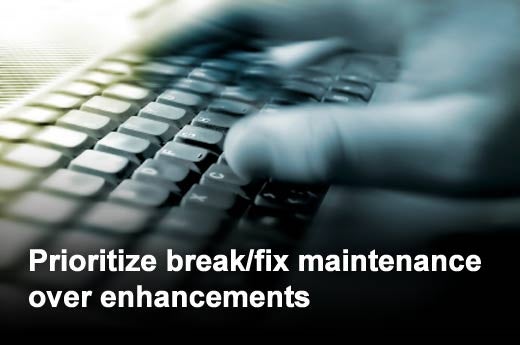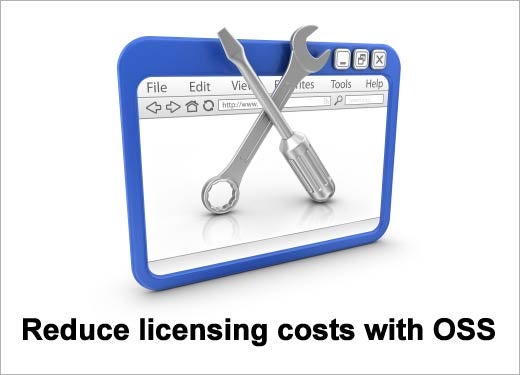With sluggish economic rebound, it remains necessary to save costs wherever possible. One area that should be considered is application maintenance services. Cutting back on service levels, negotiating with vendors, and implementing good application maintenance processes can yield short and long-term cost reduction results with minimal consequences on day-to-day business activities.
Before beginning, companies should complete a full assessment of their current application maintenance costs including:
- Refreshing the enterprise's application portfolio inventory, or starting the process if an inventory does not exist. In the face of a reduced IT budget, the department needs to take stock of assets and activities. The care and feeding of an application takes resources, and a baseline review of the service is not complete without some sort of inventory check of IT supported applications.
- Reviewing services and service levels. Current service levels offered to the department for application changes must be reviewed. If internal Service Level Agreements (SLAs) are in place with business units, a review of current expectation should be revisited.
- Reviewing current maintenance and licensing contracts for COTS applications. Reviewing what level of support is currently being offered can translate into cost saving opportunities. As well, existing licensing arrangements may not be ideal for the enterprise's needs or reveal instances of over-licensing.
- Reviewing contracts for outsourced maintenance on custom applications. Find out what the current maintenance rates are for outsourced application maintenance. This information needs to be delivered to business stakeholders in order to justify the need for service reductions. For example, where the business pushes back on reduced time to completion of application enhancements, a cost per maintenance hour can be relayed back as the cause for the delay given a reduced maintenance budget.
- Reassessing application enhancement projects. A look at the current project portfolio is always recommended in organizations looking to reduce costs. Application enhancement projects approved prior to a shift in the enterprise's financial position should be reevaluated.
In this slideshow, Info-Tech Research Group highlights a variety of expense reduction techniques and their respective impacts on budget and business. These tactics are classified by the time to realize targeted savings.
Click through for strategies and tactics that can be used to reduce application management costs, from Info-Tech Research Group.
Reductions relating to application maintenance services are very limited in the short term as most involve a change in processes which take time to implement and even longer to demonstrate ROI. However, for enterprises needing to immediately scale back on the number of IT working hours without losing the ability to serve the business, there are some quick implementation tactics that can immediately reduce or delay the need for application maintenance resources.
Reduce maintenance workload by placing a moratorium on, or at least giving heavy scrutiny to, application enhancements before carrying them out. Where the IT budget must be cut back significantly and immediately, reducing hourly maintenance costs from outsourced maintenance providers or by cutting back on the amount of internal staffing hours required will have an immediate result on the number of requests maintenance staff can handle.
Workarounds can be documented and used on a temporary basis to avoid the costs associated with programming a real fix. Once a workaround solution is discovered for a problem, it can be published into a standard operating procedure. So instead of actually performing the maintenance, users are walked through a series of steps to arrive at the same conclusion. A permanent fix can be made when resources are more readily available or bundled into a future version release.
Optimizing patching practices is a cost saver on two fronts. On the one hand, reducing the amount of time spent patching increases productivity at a time when labor is at a premium. On the other hand, by keeping strong patching practices, security threats are minimized which could cause further disruption.
- Prioritize must-have patch installation. Reduce hours spent updating patches by ensuring only priority patches are installed (i.e. those with security or core functionality purposes).
- Automate patching. Automating tools reduce time spent on testing, installing and monitoring patch priority. It also makes it easier to rollback patches when problems appear.
The tactics for mid-term expense management typically represent opportunities for replacing solutions that have upcoming expiring contracts with more affordable solutions.
For enterprises seeking to specifically reduce maintenance costs on the balance sheet, a wide variety of on-demand solutions are available which would eliminate maintenance and support by offloading it to the software provider. Implementation of Software-as-a-Service (SaaS) can be an effective measure if the cost to maintain the alternative traditional software is particularly high due to the lack of in-house skills or a vendor that has been incrementally raising maintenance fees. It's also a way to reclassify spending from asset to expense in an environment that has seen capital expenses reduced in the IT budget.
Before paying for maintenance based on seats make sure the enterprise does not get caught paying for maintenance on licenses that are no longer being used.
Applications with high licensing costs can be replaced with open source software (OSS). While there are maintenance costs associated with OSS, it provides an alternative to applications with heavy upfront licensing fees.
Some vendors have been known to increase maintenance costs to make up for lagging sales. There are several alternatives for dealing with increasing maintenance levels.
- Leverage size in negotiations. Larger enterprises may be able to use the size of their account with a vendor to place limitations on maintenance increases. This, however, depends on the vendor.
- Consider alternative applications if maintenance costs continue to increase. If a vendor refuses to renegotiate on maintenance fees and costs continue to rise unchecked, then it may be time for a new solution. This is a potential option where vendors are too big to negotiate down on maintenance fees, but a smaller provider can offer a similar solution at a lower cost.
In some cases a solution to high vendor maintenance costs is to look for a third-party provider for maintenance.
Enterprises can cut some fat out of their vendor agreements by reducing support service levels. The vendor may have tiers with gold standard levels comprised of 24-hour support service and a quick resolution time, whereas a silver level of 12-hour support might still satisfy enterprise needs at half the cost. Another option is to drop maintenance entirely except for patch updates.
Long-term tactics in cost reduction for application maintenance services focuses on maintenance for custom and in-house applications. Many of these recommendations require a significant time investment but the pay-back is long-term and goes above and beyond reducing application maintenance expenses.
The value of retiring legacy applications whose role has been supplanted by newer solutions goes beyond reduced maintenance. Backup and storage, help desk costs, network and DRP costs all increase with each additional application supported. When short-sighted, cost-driven project prioritization pushes application retirement projects out of the queue, the costs of supporting those applications continue to weigh down the enterprise.
Standardizing applications cuts costs by allowing enterprises to cover more ground with the same resources. Coding, for example, may require unique skills for an enterprise application. Where multiple branches are running two different applications with distinct programming types, additional support may be required. Furthermore, the work involved in making these applications compatible will increase the amount of work involved in maintenance. The more applications that are introduced, the more complex the environment becomes and the higher the maintenance costs.
Best practices in the way application changes are proposed, approved, and executed reduces maintenance pain. Enterprises that simply carry out all change requests on a first-come, first-served basis are both taking on an unnecessarily heavy maintenance workload and performing a disservice to the business by carrying out actions that are not aligned with business needs.
Moving to a regular release schedule can reduce the cost associated with application maintenance. Ensuring that application changes are made without destabilizing the environment involves a series of activities. Following a routine release procedure is essential to ensure stability in application environments; however, it is much more time effective to combine these changes into a single release.
Reduce instability in the application environment with strong release management practices. A formal process that ensures coding errors are caught as early as possible in the maintenance process reduces further problems down the line and reduces the cost of quality control. By employing peer code review prior to quality assurance, functional, and regression testing, mistakes can be caught earlier resulting in lower testing costs and reducing the impact of the errors.
Outsourcing maintenance costs for custom apps gives flexibility in the staffing mix while the benefit of offshoring is in labor costs. The hourly employee costs tend to be significantly lower in offshoring nations such as India and the Philippines. And, while managing offshore partners can be challenging, enterprises with a large volume of application maintenance work are likely to benefit from the discount.





















